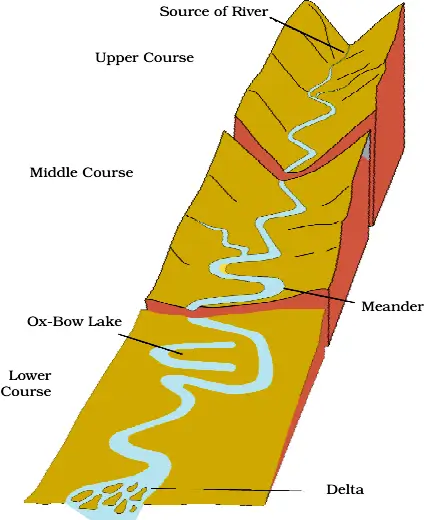Revision Notes of Geography for Class 9 Chapter 3 Drainage
The term drainage describes the river system of an area. Small streams flowing from different directions come together to form the main river which ultimately drains into a large water body such as a lake or a sea or an ocean. The area drained by a single river system is called as Drainage Basin.
Drainage Systems in India
It is controlled by broad relief features of Indian subcontinent. Accordingly, the Indian rivers are divided into two major groups – the Himalayan rivers and the Peninsular rivers.
The Himalayan Rivers
- Most of the Himalayan rivers are perennial and receive water from rain and melted snow from lofted mountains.
- Its major rivers are the Indus, the Ganga and the Brahmaputra. These rivers are long and are joined by many large and important tributaries. A river along with its tributaries may be called a river system.
- The two major Himalayan rivers, the Indus and the Brahmaputra originate from the north of the mountain ranges. They make gorges and have long courses from their source to the sea.
- They perform intensive erosional activity in their upper courses and carry huge loads of silt and sand.
- In the middle and the lower courses, these rivers form meanders, oxbow lakes, and many other depositional features in their floodplains. They also have well-developed deltas.
![Revision Notes Geography Class 9 Chapter 3 image 1]() Himalayan River System
Himalayan River System
The Indus River System
- It rises in Tibet, near Lake Mansarowar and flowing west entering India in the Ladakh.
- Its total length is of 2900 km and a little over a third is in India.
- Left bank tributaries: The Zaskar, Jhelum, Chenab, Ravi, Beas, Satluj etc.
- Right bank tributaries: Shyok, Hunza, Gilgit, Khurram, Gomal etc.
- It flows through Baltistan and Gilgit and emerges from the mountains at Attock.
- The Satluj, the Beas, the Ravi, the Chenab and the Jhelum join together to enter the Indus near Mithankot in Pakistan.
The Ganga River System
- The headwaters of the Ganga, called the ‘Bhagirathi’ is fed by the Gangotri Glacier and joined by the Alaknanda at Devaprayag in Uttarakhand. At Haridwar, the Ganga emerges from the mountains on to the plains.
- The length of the Ganga is over 2500 km. Ambala is located on the water divide between the Indus and the Ganga river systems. The plains from Ambala to the Sunderban stretch over nearly 1800 km.
- It develops large meanders during its middle course.
- Major Tributaries: The Yamuna, the Ghaghara, the Gandak, the Kosi, Chambal, the Betwa and the Son.
Yamuna River
The river Yamuna rises from the Yamunotri Glacier in the Himalayas. It flows parallel to the Ganga and as a right bank tributary meets the Ganga at Prayagraj (Allahabad).
- It flows eastwards till Farakka in West Bengal which is the northernmost point of the Ganga delta. Here the river bifurcates into the Bhagirathi-Hooghly (a distributary) and flows southwards through the deltaic plains to the Bay of Bengal.
- The mainstream flows southwards into Bangladesh and is joined by the Brahmaputra. Further downstream, it is known as the Meghna.
- This mighty river, with waters from the Ganga and the Brahmaputra, flows into the Bay of Bengal. The delta formed by these rivers is known as the Sundarban Delta.
The Brahmaputra River System
- The Brahmaputra rises in Tibet, east of Mansarowar lake and flows eastwards parallel to the Himalayas. Most of its course lies outside India.
- It takes a ‘U’ turn at Namcha Barwa (7757 m) and enters India in Arunachal Pradesh through a gorge. Here, it is called the Dihang. It is joined by the Dibang, the Lohit, and many other tributaries to form the Brahmaputra in Assam.
- In India, it carries large volume of water and silt, as it flows from high rainfall region.
- It has a braided channel in its entire length in Assam and forms many riverine islands.
- It shifts its channel frequently as huge deposit of silt causing the riverbed to rise and responsible for large-scale flooding every year.
The Peninsular Rivers
- Many Peninsular Rivers are seasonal as their flow is dependent on rainfall.
- These have shorter and shallower courses.
- Some of them originate in the central highlands and flow towards the West.
- The main water divide in Peninsular India is formed by the Western Ghats.
- Most of the peninsular rivers flows into Bay of Bengal and make delta on their mouth.
- The Narmada and the Tapi are the only long rivers, which flow West and make estuaries.
- The drainage basins of the peninsular rivers are comparatively smaller in size.
- The main West flowing rivers are Sabarmati, Mahi, Bharathpuzha and Periyar while the East flowing rivers are Damodar, Brahmani, Baitarni and Subarnrekha.
The Narmada Basin
- It rises in the Amarkantak Hills in Madhya Pradesh and flows towards the West in a rift valley formed due to faulting.
- Picturesque locations:
- Marble rocks’ (near Jabalpur): Here the river flows through deep gorge.
- Dhuadhar falls: Here the river plunges over steep rocks.
- All its tributaries are very short and most of these join the mainstream at right angles.
- Its basin covers parts of Madhya Pradesh and Gujarat.
The Tapi Basin
- The Tapi rises in the Satpura ranges, in the Betul district of Madhya Pradesh.
- It flows in a rift valley parallel to the Narmada.
- Its basin covers parts of Madhya Pradesh, Gujarat and Maharashtra.
The Godavari Basin
- It is largest peninsular river and rises from the slopes of the Western Ghats in the Nasik district of Maharashtra.
- Its length is about 1500 km and drains into the Bay of Bengal.
- The basin covers parts of Maharashtra (about 50 per cent of the basin area lies in Maharashtra), Madhya Pradesh, Odisha and Andhra Pradesh.
- Right Bank Tributaries: Pravara, Manjira, Manair, Kinnerasani etc.
- Left Bank Tributaries: Purna, Pranahita, Indravati, Tliperu, Sabri etc.
- The Manjra, the Wainganga and the Penganga are large tributaries.
- It is also known as the Dakshin Ganga because of its length and the area it covers.
The Mahanadi Basin
- It rises in the highlands of Chhattisgarh and flows through Odisha.
- The length of the river is about 860 km.
- Its drainage basin is shared by Maharashtra, Chhattisgarh, Jharkhand, and Odisha.
- Left Bank Tributaries: Seonath, Mand, Ib, Hasdeo etc.
- Right Bank Tributaries: Ong, Parry, Jonk, Telen etc.
The Krishna Basin
- It rises from a spring near Mahabaleshwar and flows for about 1400 km.
- Its drainage basin is shared by Maharashtra, Karnataka and Andhra Pradesh.
- Left Bank Tributaries: Bhima, Dindi, Peddavagu, Musi, Paleru, Munneru etc.
- Right Bank Tributaries: Kudali, Venna, Koyana, Panchganga, Dudhganga, Ghtaprabha, Malprabha, and Tungabhadra.
The Kaveri Basin
- It rises in the Brahmagri range of the Western Ghats and its total length is about 760 km.
- It reaches the Bay of Bengal in south of Cuddalore in Tamil Nadu.
- Left Bank Tributaries: Harangi, Hemavati, Shimsha, Arkavathy.
- Right Bank Tributaries: Lakshamana, Tirtha, Kabini, Bhavani, Noyyal, Amravati, Moyar etc.
- Its basin drains parts of Karnataka, Kerala and Tamil Nadu.
![Revision Notes Geography Class 9 Chapter 3 image 2]() Lakes
Lakes
- India has many lakes which differ from each other in size and other characteristics.
- A meandering river across a floodplain forms cut-off that later develops into ox-bow lakes.
- Spits and bars form lagoons in the coastal areas. For example – the Chilika lake, the Pulicat lake and the Kolleru lake.
- The lakes in the region of inland drainage are sometimes seasonal. For example, the Sambhar lake, a salt-water lake in Rajasthan.
- Most of the freshwater lakes are in the Himalayan region are of glacial origin. They formed when glaciers dug out a basin, which was later filled with snowmelt.
- The Wular lake in Jammu and Kashmir is the result of tectonic activity. It is the largest freshwater lake in India.
- The Dal lake, Bhimtal, Nainital, Loktak and Barapani are some other important freshwater lakes.
- Apart from natural lakes, the damming of the rivers for the generation of hydel power has also led to the formation of lakes, such as Guru Gobind Sagar (Bhakra Nangal Project).
Significance of Lakes
- It helps to regulate the flow of a river.
- It prevents flooding during heavy rains and helps to maintain an even flow of water during the dry season.
- It can also be used for developing hydel power.
- They moderate the climate of the surroundings; maintain the aquatic ecosystem, enhance natural beauty, help develop tourism and provide recreation.
Role of Rivers in the Economy
- Water from rivers is a basic natural resource which is essential for various human activities.
- These are used for irrigation, navigation, hydro-power generation which helps to a country like India where agriculture is the major source of livelihood of the majority of its population.
River Pollution
- River’s water quality is naturally affected by the growing domestic, municipal, industrial and agricultural demand.
- The volume of rivers is reducing as more and more water is being drained out of it.
- Untreated sewage and industrial effluents affect not only the quality of water but also the self-cleansing capacity of the river.
Interesting points
- The world’s largest drainage basin is of the Amazon River.
- An elevated area, such as a mountain or upland, which separates two drainage basins is known as a water divide.
- Indus Water Treaty (1960): India can use only 20 per cent of the total water carried by the Indus river system.
- Sunderbans Delta:
- It derived its name from the Sundari tree, which grows well in marshland.
- It is the world’s largest and fastest growing delta and is the home of Royal Bengal tiger.
- Namami Gange Programme: It is an Integrated Conservation Mission approved as a ‘flagship programme’ by the Union Government in June 2014 to accomplish the twin objectives of effective abatement of pollution, conservation and rejuvenation of the national river, Ganga.
- Brahmaputra is known as the Tsang Po in Tibet and Jamuna in Bangladesh.
- The Narmada River Conservation mission has been undertaken by the government of Madhya Pradesh by a scheme named Namami Devi Narmade.
- Seas: They are lakes of large extent such as the Caspian, the Dead and the Aral seas.
- The river Kaveri makes the second biggest waterfall in India known as Shivasamudram Falls. The hydroelectric power generated from the falls is supplied to Mysuru, Bengaluru and the Kolar Gold Field.
- Coastal plains between Western Ghats and the Arabian Sea are very narrow.


 Himalayan River System
Himalayan River System Lakes
Lakes
